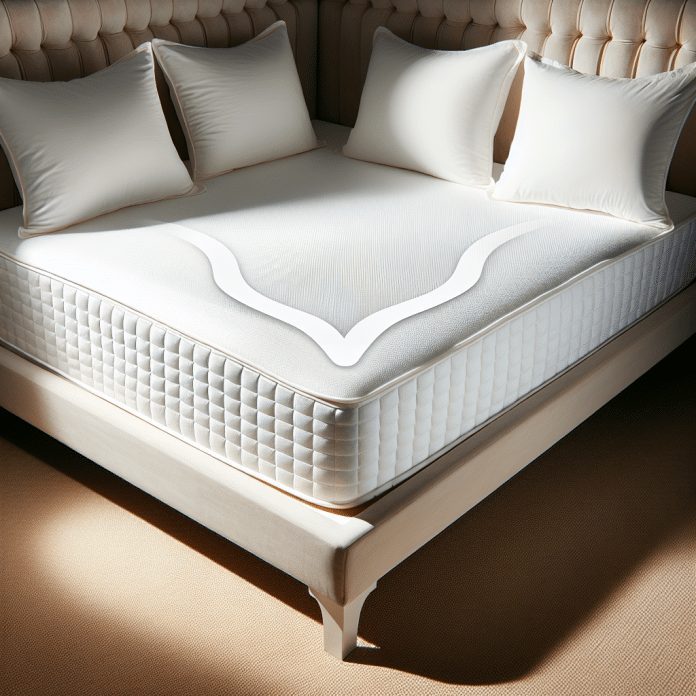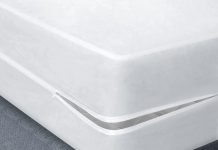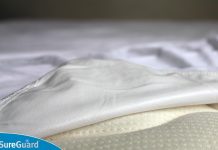Getting a mattress protector for your thick mattress is a smart move – it helps protect against spills, stains, and even dust mites. But if you’re wondering how to actually put it on, fret not! We’ve got you covered. In this article, we’ll share some simple tips and tricks to easily put a mattress protector on a thick mattress, ensuring both your mattress and sleep stay protected. Say goodbye to worrying about accidental spills or stains and hello to a clean and comfortable night’s rest!
Review contents
Preparing the mattress
Remove all bedding
Before putting on a mattress protector, it’s important to remove all bedding from the mattress. This includes sheets, blankets, and any other items that may be covering the mattress. By starting with a clean slate, you can ensure that the mattress protector fits properly and provides the best level of protection.
Measure the mattress
To ensure that you choose the right size of mattress protector, it’s essential to measure your mattress beforehand. Mattresses come in various sizes, such as twin, full, queen, and king. By measuring the length, width, and depth of your mattress, you can purchase a protector that fits snugly and securely.
Clean the mattress
Before applying a mattress protector, it’s a good idea to clean the mattress surface. Use a vacuum cleaner to remove any dust or debris that may have accumulated. If there are any stains or spills on the mattress, spot clean them with a mild detergent and water. Ensuring a clean surface will not only improve the fit of the protector but also maintain the overall hygiene of your mattress.
Choosing the right mattress protector
Consider the mattress type
Different types of mattresses require different types of protectors. For example, if you have a memory foam mattress, look for a protector that is specifically designed for memory foam. Similarly, if you have a latex or hybrid mattress, consider a protector that is suitable for those types of mattresses. By choosing a protector that is compatible with your mattress type, you can maximize its benefits and ensure a proper fit.
Check the protector’s depth
Mattress protectors come in various depths to accommodate different mattress thicknesses. When choosing a protector, make sure to check the depth measurements mentioned on the packaging or product description. Ideally, the protector should have a snug fit around the edges of the mattress, without being too tight or loose. A properly fitted protector will not only stay in place but also provide optimal protection.
Look for elasticized corners
One of the key features to look for in a mattress protector is elasticized corners. These corners ensure a secure fit and prevent the protector from slipping or sliding off. When shopping for a protector, check if it has elasticized corners and if they are well-constructed. This feature will make it much easier to put on and remove the protector when needed.
Putting on the mattress protector
Stretch the protector over the mattress
To start putting on the mattress protector, hold one end of the protector and stretch it over the corner of the mattress. Gradually work your way around, pulling the protector over each corner until it covers the entire surface. Take your time to ensure that the protector is evenly stretched and smooth.
Secure the corners
Once the protector is in position, secure the corners by tucking them under the mattress. This will help keep the protector in place and prevent it from shifting during the night. Make sure the corners are securely tucked, but avoid pulling the protector too tightly, as it may cause unnecessary strain or damage.
Smooth out any wrinkles
After securing the corners, carefully smooth out any wrinkles or creases on the surface of the protector. This will not only provide a neat appearance but also alleviate any discomfort that may arise from uneven surfaces. Smooth out the protector by gently patting it down with your hands or using a flat object, such as a book or a large spatula.
Testing the fittedness
Check for proper coverage
Once the mattress protector is in place, check to ensure that it provides proper coverage. The protector should completely cover the top surface of the mattress, extending over the edges without hanging or sagging. Look for any areas where the protector may not be fitting snugly and make any necessary adjustments to ensure complete coverage.
Ensure the protector stays in place
To ensure that the mattress protector stays in place throughout the night, gentle movements and sleep, it’s important to perform a quick test. Sit or lie down on the mattress and try moving around to simulate normal sleep movements. Check if the protector stays securely in position or if it slides or shifts. If it remains in place, you can have peace of mind knowing that your mattress is well-protected.
Additional tips and considerations
Use a helper if necessary
If you have a thick or heavy mattress, it can be challenging to put on the protector by yourself. In such cases, consider enlisting the help of a friend or family member. Having an extra set of hands can make the process easier and reduce the risk of straining yourself or damaging the protector.
Consider using a mattress topper
If your mattress is particularly uncomfortable or shows signs of wear and tear, consider using a mattress topper in addition to the protector. A mattress topper can provide extra cushioning and support, enhancing your overall sleeping experience. When applying the protector, ensure that it covers both the mattress and the topper for comprehensive protection.
Read and follow manufacturer’s instructions
Lastly, it’s always advisable to read and follow the manufacturer’s instructions that accompany the mattress protector. Each protector may have specific care instructions or recommendations for maintaining its quality and effectiveness. By adhering to these guidelines, you can prolong the lifespan of the protector and ensure that it continues to provide maximum protection for your mattress.
In conclusion, putting a mattress protector on a thick mattress requires proper preparation, careful selection, and precise application. By following the steps outlined above, you can ensure a snug fit, adequate coverage, and optimal protection for your mattress. Remember to evaluate your mattress type, measure its dimensions, and choose a protector that meets your specific needs. By doing so, you’ll be able to enjoy a clean, hygienic, and comfortable sleeping environment for years to come.































